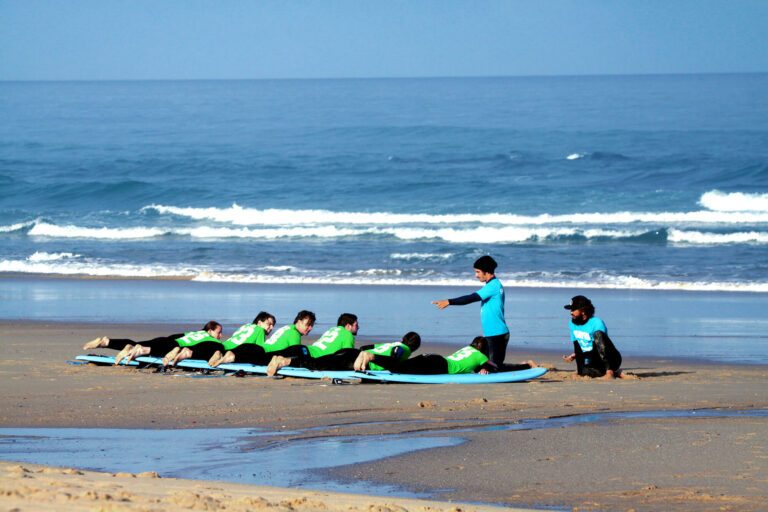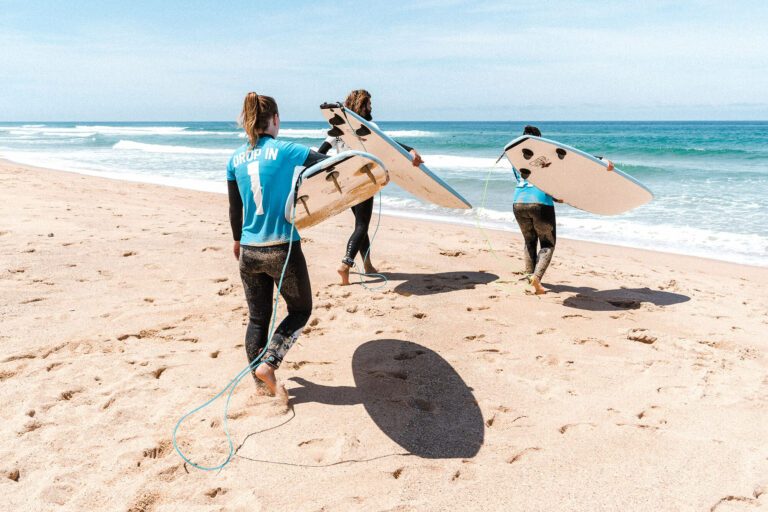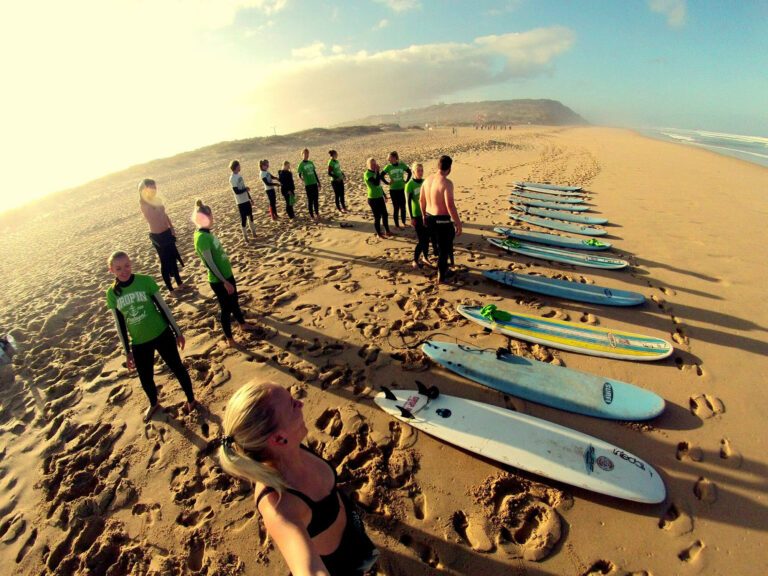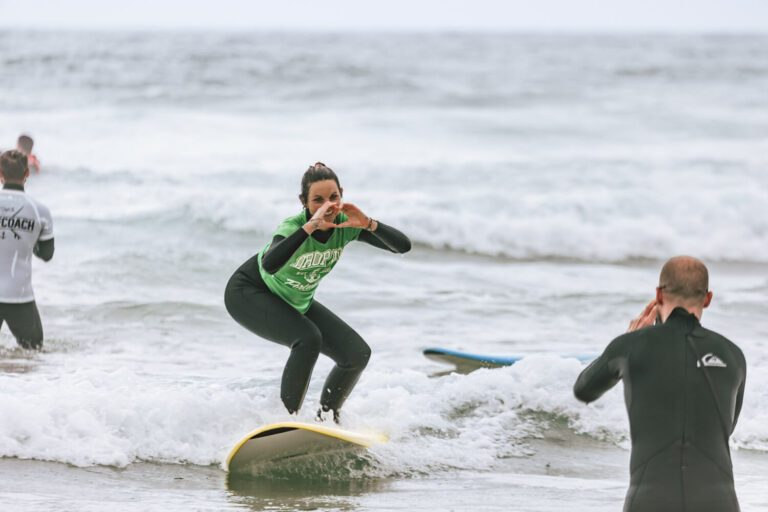
Learn surfing
The basics of surfing
We always recommend taking a surf course to learn to surf, i.e. to learn the basics or to improve your surfing skills. And here you can learn a few tricks of the trade before you get on the board…

The Take Off
The most important thing in surfing is the take off. This principle describes the process of gliding the wave and jumping on the surfboard.
The take off on the beach
The best place to start is practicing your take-off on the beach. Draw a line in the sand that simulates the center of the board. Now lie on the line, place your hands close to the body at the level of the first ribs. Now stand up, as if doing a push-up, in a quick sequence. It is important that you rotate your upper body so that the end position of the shoulders is parallel to the board! Once this movement is second nature to you, you’re ready to hit the water.
The take off in the white water
In the beginning you should practice the take off in white water to get a feeling for the wave power and the board. After a few attempts at sliding on your stomach, it’s time to try your luck with the take-off! you’ll quickly notice that it’s much more difficult in the water than on the beach.
The Take Off in the Line Up
You should not paddle into the line-up (the breaking line of the wave) until you are confident with the take-off in white water. Taking the wave in the “green” again requires a lot of practice and a good eye for the wave:
you wait sitting on your board at a right angle to the wave in the line up – this way you have the waves and the beach equally in view and can quickly turn to paddle the waves.
If you now have a clear path and the “perfect” wave rolls in, you now turn towards the beach and paddle off before the wave has reached you. Here lies the greatest difficulty in surfing: Reading the waves, i.e. do I have to paddle fast or wait a little longer so that I catch the wave perfectly… When the wave reaches you, the board lifts up behind you. Don’t stop paddling now, but turbo-charge now more than ever!
At first, you think you’ll fall over in front – but that’s just how it feels (most of the time :)). Now, when you have caught the wave in the right place, you start to glide. Now put your hands on the board and jump on the board in a fast and fluid motion. The important thing is to stay on your knees, that way you’ll have better balance.
The faster and smoother your take off, the smoother the board will behave in the water. Timing is crucial for bouncing. If the wave is still too flat, it won’t take you – if it’s already too steep, you’ll get your free wash.
Proper paddling
Proper paddling is one of the most important techniques of surfing. You need good timing and a lot of power.
To paddle correctly and optimally, you need an optimal position on the board! Your nose should stick out of the water as close as possible – this way you bring your board into the “straightest” position and thus have the least water resistance.
Important is additionally your body tension! Always go into the hollow back, so that you create tension in the back and thus better transfer your power into the water. Make sure you keep your legs tense and together as well so they don’t “drag” in the water.
Always paddle with full power, steady and deep arm strokes will help you build speed.
Before you go surfing, always watch the spot first! There is actually always a channel – here the water is deeper and the current pulls you out – where it is much easier to get into the line up. In the channel, fewer and smaller waves break with less power.
Diving techniques
The line up is the starting position for surfing. To get there you have to paddle a lot and dive through waves. Here you can find some diving through techniques.
As long as you can stand in the water, the easiest way is to jump over the waves with your board. Always make sure to keep the board next to you or you’ll get punched in the nose.
The Eskimo Roll
Just before the white water reaches you, grab the rails and turn under your board, flipping over. Your board is now lying with the fins up. Now hold on tight – the wave is now running over you. Once the white water has rolled over you, turn back to your board and paddle on as quickly as possible. It is important that you always make sure that the nose is in the water, otherwise the white water presses between you and your board and tears it out of your hand!
The Duck Dive
Duck Dive is diving “under” the wave. The smaller the board, the easier and deeper the Duck Dive. Here you dive into the water like a duck.
When the foam roller rolls towards you, grab your board at the front of the rails and shift your weight forward so that the board dips nose first. When diving in, angle one of your legs (usually your back foot when surfing) so that your knee is just below your hip – your other leg you extend away upward. Just before the white water reaches you (or is above you), pull your upper body to the board under water and push the board completely under water with your knee. The pressure of the knee shifts the weight further back so that you shoot your board back to the surface on the backside of the wave.
The Duck Dive requires a lot of practice and experience.
Handling the surfboard
When dealing with surfboards, there are a few things for surfers to keep in mind. This includes some rules that must be followed to protect surfers as well as others in the water and on the beach.
It is important to know how to properly carry the board. On the beach you always keep the leash (connecting line) high and taut. That way, there’s no risk of you tripping or it getting caught on the ground.
The fins always point inward when worn. If you wear it the other way around, it can be dangerous for other people. If the wind or a wave turns your board, that’s enough for a severe injury.
When you go into the water, it is very important that you carry your board sideways, otherwise the waves will throw it back or fling it at you.
Never hold your board by the leash! In a wave, the board can be rotated several times, constricting the fingers.
Proper falling down
As a surfer, you often fall off the board. To make sure you don’t hurt yourself in the process, there are some basic rules to fall safely.
If you cannot delay falling off the board, it is important that you always fall behind or next to your board! This way you minimize the risk of getting your own board off. Always protect your head with your arms!
Depending on what surface you surf, you should adapt. If the bottom consists of rocks or reefs, you should extend all limbs and fall as flat as possible into the water. That way you don’t dive in so deep.
When falling, dive deep until you feel a pull on the leash, then surface slowly and oriented – always protect your head with both arms!
Often you think, ohhh I must be drowning, but: as a rule you are never under water for more than 6 seconds at the most – if you ever run out of air, just start counting the seconds. So you quickly realize that you often misjudge.
Although it often seems that bigger waves also bring the greatest danger, this impression is often deceptive. Smaller waves also pose a high risk of injury, as people often underestimate the force of smaller waves and drop without paying certain attention.
Should you ever find yourself in an emergency situation:
- Never leave your board – keep calm – save your strength!
- In case of problems with currents, always paddle at right angles to the current! Try to reach the refraction zone and never paddle against the current!
- If you need help, raise/wave one arm – that’s the international distress signal!
Learn surfing
You have never surfed before? Then it’s best to start with a beginner’s course in our surf school. Here in Portugal you will learn the basics of surfing quickly and effectively and can improve your surfing skills under the guidance of experienced coaches. During the training we will show you the most important techniques before you get on the board: for example, how to paddle correctly, how to keep your balance when setting up – and of course, by which signs you can recognize the perfect wave.
The goal of the beginner surf course is for you to stand safely on the board in white water – which is the broken wave. Every day there is a small unit of surf theory, from wave theory and rules of conduct on the water to special surfing techniques. Depending on the weather and wave conditions, our coaches will then take you to the best (and most suitable for your level) surf spots in the region.
Our surf coaches support you individually in learning to surf: with step-by-step explanations, practice units that build on each other and customized feedback via video analysis. Since the group consists of a maximum of 8 people, the coaches can also respond to each participant in peace.




Facts
WAVE RIDING FOR SURF NEWBIES
To learn surfing, our surf school offers the perfect conditions. Here in Portugal, directly on the Atlantic coast in the west of Europe, the conditions are ideal for surf newbies in particular for their first attempts at surfing: no hidden corals or dangerous stones (no cuts!) under water, a soft surface (no head injuries!) – and waves that are neither too high nor too deep and roll gently towards the beach. Especially our homebeach “Praia do Areal” is still a secret spot in Portugal – so in the surf course you can expect relaxed sessions and empty waves.
Learning to surf means knowing the rules that apply on and off the water. For example, the minimum distance from the other surfers. Because if you fall into the water, the board can quickly shoot once the air, fly around uncontrollably and then hit the neighboring surfer – that would not be nice! In our surf school in Portugal you will also learn how to protect yourself in case of a fall and how to get back to the water surface.
THE DROP IN SURF SCHOOL IN PORTUGAL
- Surf courses in Portugal with top surf spots
- Courses for beginners and experienced surfers (Beginner / Advanced)
- 20 hours of instruction (theory and practice)
- Daily classes from Monday to Friday
- Language of instruction: German or English
- Licensed surf instructors
- Group size: max. 8 people
- Material (surfboard, wetsuit) is provided and can also be used outside the course time
- Video analysis for individual feedback